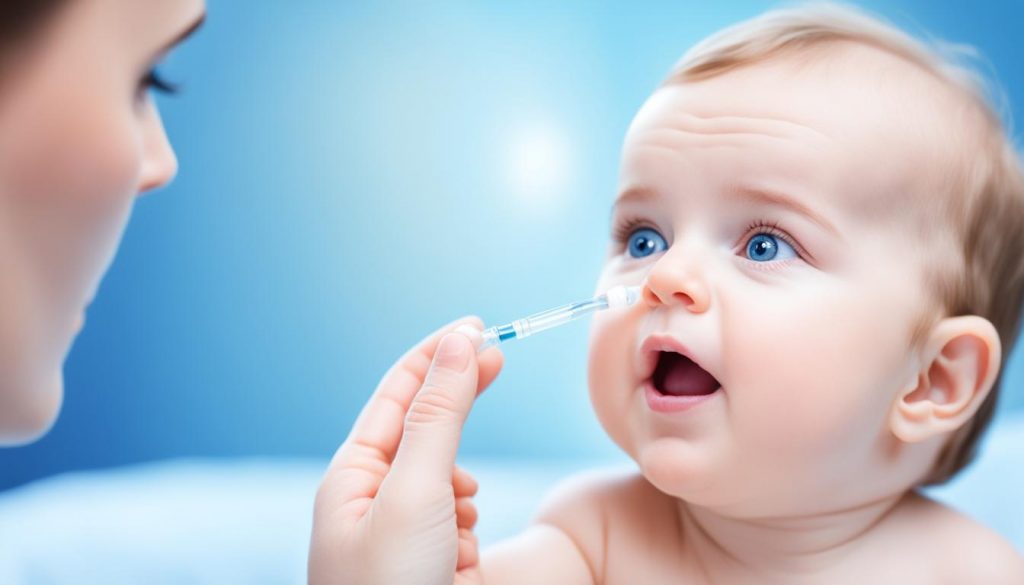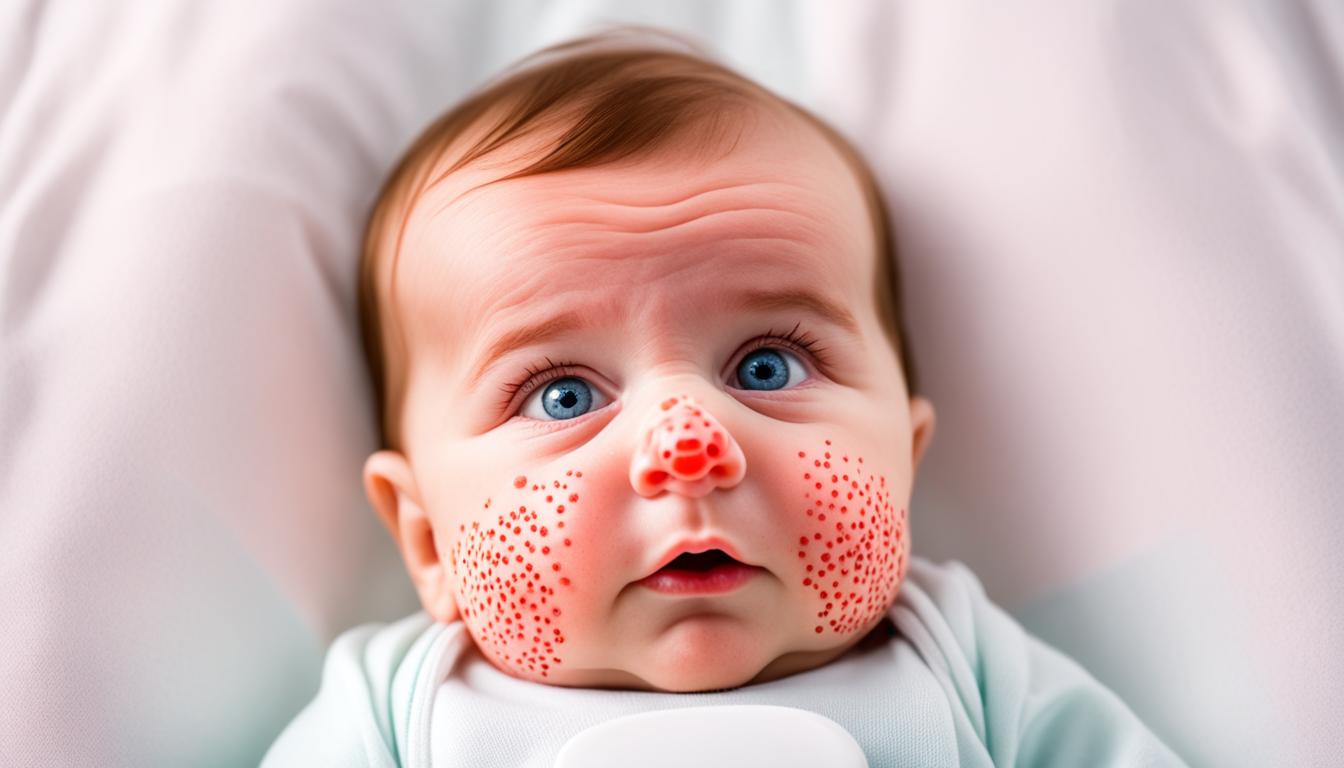Baby acne often shows up on a baby’s forehead, face, and limbs. It may appear right after birth or a few weeks later. Although it’s usually harmless and goes away on its own, some cases need treatment. Parents should look out for symptoms and get medical advice when needed.
Key Takeaways:
- Baby acne is a common condition in infants, usually appearing on the forehead, face, and limbs.
- Most cases of baby acne are harmless and resolve on their own.
- Parents should seek medical advice if the acne persists or worsens.
- Proper skincare can help prevent and manage baby acne effectively.
- Emerging therapies like stem cell therapy offer potential advancements in the treatment of baby acne.
What Causes Baby Acne?
Baby acne is common and often worries parents. The exact cause is unknown, but several factors might lead to it. Understanding these can help in handling baby acne.
Hormonal changes may cause baby acne. Experts think that mother-related hormones could affect the baby. These hormones might make the baby’s oil glands active, causing acne.
Genetics can also influence baby acne. If the family has a history of acne, the baby might face it too. This genetic link suggests some babies are more prone to acne.
The Role of Hormones in Baby Acne
Hormones play a part in causing acne in babies. During pregnancy, a baby gets exposed to the mother’s hormones. This can change the baby’s hormone levels, making oil glands overactive. Thus, acne appears.
Remember, acne isn’t due to poor hygiene. Washing too much or using strong cleansers can harm more. A gentle wash with warm water and soft cleanser is best.
Genetic Predisposition to Baby Acne
Family history could affect baby acne. If a parent had acne, their baby might be more likely to have it too. The exact genes involved are not fully known. However, a link exists between family acne history and baby acne.
Knowing possible causes helps in managing baby acne. Gentle skincare can prevent flare-ups. For persistent acne, doctors can offer advice and treatments.
| Possible Causes of Baby Acne |
|---|
| Hormonal changes, especially related to the mother’s hormones |
| Genetic predisposition to acne |
With the right care and knowledge, parents can help soothe and improve their baby’s skin health.
Types of Baby Acne
It’s key for parents to know the different types of baby acne. This helps them care for their infants’ skin properly. There are mainly two kinds: neonatal acne and infantile acne.
Neonatal Acne
Neonatal acne can show up in the first few weeks after a baby is born. It looks like small red bumps on the face and body. Even though it might worry parents, it’s usually mild. Babies don’t feel any discomfort from it. This type usually goes away on its own, without needing any treatment.
Infantile Acne
Infantile acne is also known as baby acne. It starts when babies are between 3 to 6 months old. This type of acne looks more like what adults get. It can have whiteheads, blackheads, and sometimes pus-filled bumps. Even though it can last longer and might seem worse than neonatal acne, it often goes away by itself in a few months.
To tell baby acne apart from other skin issues, like erythema toxicum or milia, look closely at the bumps. Baby acne usually shows as small red or white bumps. These can stick around for several weeks or even months before clearing up.
| Type of Baby Acne | Characteristics | Treatment |
|---|---|---|
| Neonatal Acne | Small red bumps on face and body | Usually resolves on its own without treatment |
| Infantile Acne | Resembles acne in adults, including whiteheads, blackheads, and pus-filled bumps | Usually resolves on its own within a few months |
Parents should remember that baby acne is common and temporary. Most times, it doesn’t need special treatment and will just fade away. However, if the acne stays or makes the baby uncomfortable, it’s best to see a doctor. A pediatrician or dermatologist can check the baby and suggest treatments if needed.
How to Treat Baby Acne?
Baby acne often goes away on its own, without needing treatment. However, parents can do simple things to help. These steps can improve your baby’s skin, making it clear and healthy again.
Cleanse Gently: Keeping your baby’s skin clean is essential. Wash the acne gently with warm water and a soft cleanser. Stay away from strong products that can irritate the skin more.
Avoid Picking or Scrubbing: Even though it’s tempting, don’t pinch or scrub the pimples. Doing this can hurt the skin, cause inflammation, and leave scars. Let the acne heal by itself.
Keep the Skin Moisturized: Moisturize your baby’s skin with a soft, hypoallergenic lotion. This prevents dryness and irritation, which can make acne worse. Choose moisturizers made for babies’ delicate skin.
Dress Appropriately: Dress your baby in clothes that are loose and made of breathable fabric. This stops too much sweating, which can cause acne. Don’t put too many clothes on your baby when it’s hot.
Consult a Dermatologist: If the acne doesn’t get better or gets worse, see a dermatologist. They will check your baby’s skin and may suggest special creams or medicines to help.
Baby acne is common and usually temporary. By taking these easy steps, you can soothe your baby’s skin and promote good health. Remember, most times, baby acne clears up by itself.

Baby Skincare Tips
It’s crucial for parents to start a good skincare routine for their babies early on. These baby skincare tips will help manage and prevent baby acne. This way, your baby’s skin stays healthy and clear.
- Use gentle and hypoallergenic products designed for babies: It’s best to choose products that are gentle and made for baby’s skin. These are less likely to irritate their skin or cause acne.
- Avoid harsh chemicals and fragrances: Your baby’s skin is sensitive. Avoid products with alcohol, dyes, and fragrances to prevent irritation.
- Keep the baby’s skin clean and moisturized: Clean your baby’s skin with warm water and a soft cleanser. Then, dry their skin gently and use a light moisturizer to keep it hydrated.
- Dress the baby comfortably and avoid overheating: Make sure your baby doesn’t get too hot. Dress them in light clothes and keep their room at a comfortable temperature.
By sticking to these baby skincare tips, your baby’s skin will stay healthy. This can lower the chance of getting baby acne.
Diagnosis of Baby Acne
To diagnose baby acne, doctors look for specific signs. They often see small red bumps on the baby’s face and limbs. Just seeing these bumps is usually enough for a doctor to confirm it’s baby acne.
Sometimes, doctors do more tests to check for other skin issues. These extra steps help make sure the diagnosis is right. They might look at the pus under a microscope or test it to find any bacteria or fungi.
- Microscopic examination of the pus: This is done if there’s pus in the bumps. It shows if there’s a bacterial or fungal infection that needs treating.
- Culture for bacteria and fungi: This test identifies the bacteria or fungi in the bumps. It helps rule out other skin issues that look like baby acne.
If the acne doesn’t go away or if other symptoms show up, a skin doctor might be needed. Dermatologists have special skills in treating skin problems. They can offer more help and advice.
Possible Skin Conditions That May Resemble Baby Acne
It’s key to know baby acne from other look-alike skin problems. Here are two conditions often mistaken for baby acne:
- Erythema Toxicum: This rash has red spots with small white or yellow bumps. It can show up all over the baby’s body, not just the face or limbs.
- Milia: These are tiny white bumps on the nose, cheeks, or chin. They’re caused by trapped protein in the skin, different from baby acne.
| Condition | Appearance | Location |
|---|---|---|
| Baby Acne | Small red bumps or pustules | Face, forehead, limbs |
| Erythema Toxicum | Red blotches with central white or yellow bumps | Anywhere on the body |
| Milia | Tiny, white bumps | Nose, cheeks, chin |
Stem Cell Therapy for Baby Acne
Traditional treatments like creams and antibiotics are common for baby acne. But now, stem cell therapy offers a new hope. It uses the baby’s own stem cells to heal and fix the skin. This method could lead to better and more specific ways to treat baby acne.
Stem cells are basic cells that can turn into many cell types. They repair damaged cells and help with healing. For baby acne, this therapy aims to renew the skin and lessen inflammation.
The therapy starts by taking stem cells from the baby’s umbilical cord or fat tissue. These cells are then made ready in a lab. After that, they are put on the baby’s skin where acne is.
Research shows stem cell therapy could lower redness and swelling. It also might decrease how much and how bad the acne is. Plus, it boosts collagen production. This protein is key for keeping skin elastic and firm.
But, stem cell therapy for baby acne is still being tested. It’s not yet a common treatment. More studies are needed to check its safety and how well it works. Yet, the early outcomes look good, making it an exciting field in skin care.
Always talk to a skin doctor or a child’s doctor before choosing stem cell therapy. They can offer advice and decide if it’s the right treatment for your baby.
To learn more about stem cell therapy for baby acne and other innovative treatments, continue reading the article.
Conclusion
Proper skincare is key for preventing and managing baby acne. Parents can help keep their baby’s skin healthy with the right tips. But if baby acne gets worse, it’s important to see a doctor. They can give the right diagnosis and treatment.
There are traditional treatments for baby acne, like creams and antibiotics. These can help relieve symptoms and heal the skin. Also, new treatments like stem cell therapy are showing promise. This advanced method uses the baby’s own stem cells to help repair the skin.
By being proactive and understanding baby acne, parents can protect their baby’s skin health. Even though baby acne often goes away on its own, proper care is necessary. The right treatment can reduce discomfort and keep your baby’s skin healthy.

